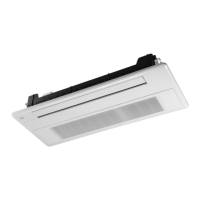21
English
Installation Procedure
7 Adjust the unit to the appropriate position, taking into
account the installation area for the front panel.
• Place the pattern sheet on the indoor unit.
• Adjust the space between the ceiling and the
indoor unit by using a dimension gauge.
• Fix the indoor unit securely after adjusting the level
of the unit by using a leveller.
• Remove the pattern sheet, connect the other
cables. and install the front panel.
Ceiling
Indoor unit
23 mm
Gauge of dimensions
Step 2 Performing the gas leak test
To identify potential gas leaks on the indoor unit, inspect
the connection area of each refrigerant pipe using a leak
detector for R-410A.
Before recreating the vacuum and recirculating the
refrigerant gas, pressurize the whole system with nitrogen
(using a cylinder with a pressure reducer) at a pressure
above 0.2 MPa, less than 4 MPa (gauge) in order to
immediately detect leaks on the refrigerant fittings.
Made vacuum for 15 minutes and pressurizing system with
nitrogen.
Liquid side
Gas side
Insulator
Step 3 Insulating the refrigerant pipes
Once you have checked that there are no leaks in the
system, you can insulate the piping and hose.
1 To avoid condensation problems, place Acrylonitrile
Butadien Rubber separately around each refrigerant
pipe.
NOTE
• Always make the seam of pipes face upwards.
CAUTION
• The insulation has to be produced in full compliance
with European regulation EEC / EU 2037 / 2000
requring the use of sheaths insulation without using
CFC and HCFC gases for heating and the environment.
2 Wind insulating tape around the pipes and drain hose
avoiding compressing the insulation too much.
Insulation cover pipe
Insulation pipe
Be sure to overlap the insulation.
Indoor unit
CAUTION
• Be sure to wrap insulation tightly without any gaps.
3 Finish wrapping insulating tape around the rest of the
pipes leading to the outdoor unit.
4 The pipes and electrical cables connecting the indoor
unit with the outdoor unit must be fixed to the wall
with suitable ducts.

